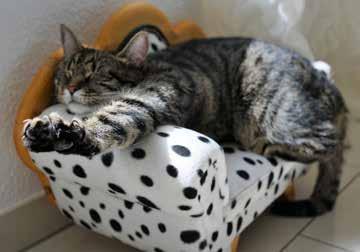
1 minute read
Vet Speak - Arthritis in Cats with Millwater Vet
vetspeak
Arthritis in Cats
Advertisement
At least 85% of cats over the age of 12 years have arthritis. Unlike dogs, cats generally won’t limp or show they are in pain. Instead, they limit how much they do to reduce their discomfort.
The main signs in cats are:
Reduced activity Only jumping onto lower surfaces Altered grooming: under- or over-grooming Changes in temperament Stiffness after sleep Difficulty using the litter box
Things you can do at home to help:
Use soft, comfortable beds placed in easily accessible, quiet, draught-free locations
Provision of a series of ‘steps’ or a ramp to allow cats to access favoured higher sites
Make sure the cat flap is very easy to open, and if necessary tie it open so the cat doesn’t need to push through Always have a litter tray inside and one that has at least one low side for easy access
Make sure that food and water area is easily accessible, at floor level or with steps up to higher levels
Having bowls slightly raised off at shoulder height will help cats with arthritis in their front limbs
Make sure the cat doesn’t have to go up or down stairs to access food, water, or litter trays
Spend time grooming and cleaning an arthritic cat as this may be difficult for them
Overgrown claws need regular cutting
Obesity or being overweight will exacerbate arthritis and so should be avoided
Check out www.catswitharthritis.com for more information
There are many options available to help keep our feline friends comfortable as they age. If you would like to discuss how we can help, pop in for a chat.

Jemma Hedges | Millwater Vet Hospital











